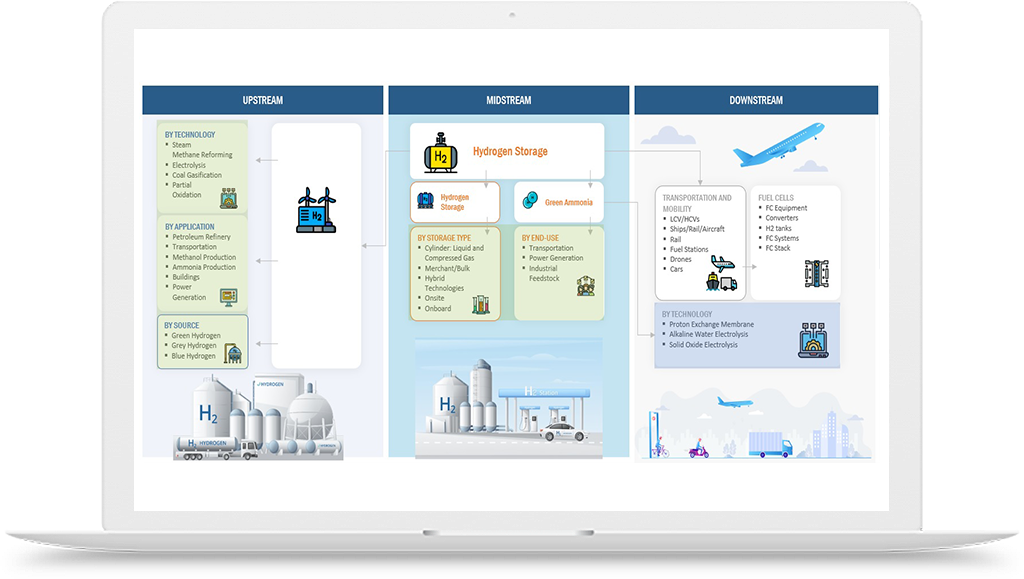Is Hydrogen the Future of Energy Storage?
Hydrogen Storage
The use of hydrogen in energy storage has a lot of promise for the future. Certain present trends and situations suggest that hydrogen has potential as an energy storage solution, even though detailed statistical data related to the future is scarce. Following are a few instances:
Excess Renewable Energy Utilization:
- When the production of renewable energy surpasses the demand, the surplus electricity can be utilized for the electrolysis process to make hydrogen. The energy is stored in the form of hydrogen by this process, which can then be used to produce electricity or energy for other purposes.
- The International Energy Agency (IEA) claims that hydrogen generated by electrolysis may be able to absorb excess electricity in power networks that have a large proportion of renewable energy sources. This would allow for the use of excess renewable energy and enhance grid stability.
Energy Storage and Grid Balancing:
- Considering the sporadic nature of renewable energy sources like sun and wind, hydrogen can be used as a long-term energy storage solution. Hydrogen, which can be produced using excess renewable energy, can be stored and used in fuel cells to generate power again when required.
- Hydrogen storage can offer a dispatchable energy source in situations where grid balancing is necessary, guaranteeing a steady and dependable supply of electricity. This capacity is essential for preserving grid stability in times of heavy demand or low production of renewable energy.
Integration with Existing Infrastructure:
- Hydrogen is easily incorporated into the current energy infrastructure, including storage facilities and pipelines for natural gas. Excess renewable energy can be converted into hydrogen using technologies such as power-to-gas. Hydrogen can then be stored underground or injected into the natural gas grid.
- This connection makes it possible to store huge amounts of hydrogen and use it later for heating, power generation, or industrial activities, utilizing the infrastructure that already exists and minimizing the need for substantial new investments.
Industrial Applications:
- Industries with distinct energy requirements may find hydrogen storage to be very helpful. Hydrogen can function as a clean and adaptable energy source, for instance, in situations when industries need high-temperature heat or particular chemical reactions that are difficult to do with electricity alone.
- The utilization of stored hydrogen for energy requirements could potentially lower carbon emissions and aid in the decarbonization of industries that are difficult to address, such steel, cement, and chemical processes.
Some relevant statistics that highlight the potential of hydrogen as an energy storage solution:
- The global market for hydrogen energy storage might reach a cumulative capacity of 3,000 gigawatt-hours (GWh) by 2050, indicating a $2.5 trillion market opportunity, according to a report by the Hydrogen Council and McKinsey & Company.
- By 2050, hydrogen-based long-duration energy storage might have a 1,000 GWh capacity, according to projections from the International Renewable Energy Agency (IRENA), which would assist fulfill the growing demand for grid flexibility and renewable energy integration.
Real-World Scenarios: Several real-world scenarios demonstrate the potential of hydrogen as an energy storage solution:
- Power-to-Gas:The "WindGas" project in Germany is investigating the electrolysis of surplus wind energy to produce hydrogen. After manufactured, the hydrogen is either fed back into the natural gas system or used as fuel to generate electricity, thereby supplying energy storage and balancing.
- Offshore Wind Integration: The "Surf 'n' Turf" project, which combines hydrogen production and storage with wind and tidal energy, is located in the Orkney Islands in Scotland. Through the process of electrolysis, the excess renewable energy is converted to hydrogen, which is subsequently stored and used to either power cars or produce electricity.
- Remote Applications: Hydrogen-based energy storage can be advantageous in remote or off-grid places where access to conventional energy infrastructure is restricted. For example, the United States' Smart Power Infrastructure Demonstration for Energy Reliability and Security (SPIDERS) project uses hydrogen storage systems to supply military bases in remote areas with clean, dependable power.
Technological Advancements in Hydrogen Industry:
The goals of ongoing research and development are to lower prices, increase efficiency, and advance hydrogen storage technology. Among the noteworthy developments are:
- Advanced Electrolysis: Technological advancements in electrolysis are reducing the cost and increasing the efficiency of hydrogen production. Cost-effective hydrogen production is made possible by the increasing scalability, compactness, and responsiveness of electrolyzers.
- Hydrogen Storage Materials: Researchers are looking into cutting-edge methods and materials for storing hydrogen, such as metal hydrides and solid-state hydrogen storage technologies. These substances may be able to improve safety, expand storage capacity, and facilitate more effective hydrogen use.
Policy Support and Investments in Hydrogen Market:
Governments and businesses in the private sector are beginning to see the value of hydrogen as a solution for energy storage and are supporting it with investments and legislation. Among the instances are:
- By 2030, 40 GW of electrolyzer capacity is the ambition for the European Union's Hydrogen Strategy, which intends to create a complete hydrogen value chain that includes energy storage.
- A number of nations have introduced national hydrogen strategies that detail plans for the production, storage, and use of hydrogen. These nations include Australia, Germany, Japan, South Korea, and South Korea.
When thinking about hydrogen as the energy storage of the future, scalability, capacity, and infrastructure are in fact important considerations. Let's examine these features in more detail:
Scalability and Capacity:
- The ability to increase hydrogen production, storage, and consumption in response to rising demand is referred to as scalability. Technological developments in areas like electrolysis and fuel cells are required to guarantee that hydrogen can be efficiently scaled up while also lowering prices and increasing production capacity.
- The ability of hydrogen storage systems to meet the demands of large-scale energy storage is critical. In comparison to conventional fossil fuels, hydrogen has a lower volumetric energy density even if it has a high energy density per unit weight. Larger storage volumes are therefore needed. Research and development, including the investigation of cutting-edge materials and storage techniques, is being done to increase the density and storage capacity of hydrogen.
Infrastructure Development:
- The widespread use of hydrogen as an energy storage technology depends on the development of a strong hydrogen infrastructure. This involves setting up infrastructure for the distribution, transportation, and manufacture of hydrogen.
- To ensure the usefulness and convenience of hydrogen fuel cell vehicles and to enable their adoption, a network of hydrogen recharging stations must be built. Infrastructure for hydrogen refueling is being developed by public and private sectors, although creating a complete network is still difficult, especially in areas with poor infrastructure.
- In order to take advantage of the current pipeline networks for hydrogen distribution and storage, it is also being investigated to modify the current natural gas infrastructure to accept hydrogen.
Cost Considerations:
- One major worry is the cost of producing, storing, and using hydrogen. At the moment, hydrogen is more expensive than traditional fossil fuels. But over time, cost reductions are anticipated as a result of economies of scale, technological breakthroughs, and favorable legislation.
- The main technique for producing hydrogen, electrolysis, involves electricity, and the price of renewable electricity is a major factor in figuring out how cost-competitive hydrogen is. Hydrogen production prices are anticipated to reduce in tandem with the ongoing decline in the cost of renewable energy.
- Moreover, improvements in materials science, including more effective catalysts for electrolyzers, can help cut costs. The goal of research and development is to increase the fuel cell's longevity and efficiency, which will raise the overall cost-effectiveness of storing and using hydrogen.
Safety Considerations:
- Because hydrogen is a highly combustible gas, safety is of the utmost importance when handling it. Every step of the hydrogen value chain, from production to storage, transit, and use, needs to have appropriate safety precautions and procedures in place.
Guidelines, rules, and industry standards are being created to guarantee the safe handling, storing, and transportation of hydrogen. Modern technology is being used to improve infrastructure and hydrogen storage safety. Examples of these innovations include safety valves and sophisticated leak detection systems.
















